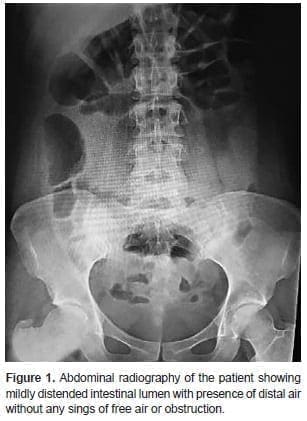PRESENTACIÓN DE CASO
Conservative approach for a rare cause of acute abdominal pain
Síndrome pospolipectomía de presentación como “microperforación” y neumoperitoneo:
Abordaje conservador para una rara causa de dolor abdominal
Anwar Medellín1, Eric E. Vinck2, Luis Cabrera2, Tim Peterson3
1 Department of Colorectal Surgery; Universidad Militar Nueva Granada. Bogotá, Colombia
2 Department of Surgery; Universidad El Bosque. Bogotá, Colombia
3 Department of Surgery; Universitair Ziekenhuis Brussel – VUB, FACS. Universitair Ziekenhuis Brussel, Jette, Bélgica
Resumen
Introducción. El Síndrome Pospolipectomía es una causa rara de dolor abdominal posterior a resecciones de pólipos por colonoscopia, cuyo caso, en ciertos pacientes se debe considerar el manejo conservador.
Métodos. Se revisa la literatura sobre el síndrome en mención y se reporta un caso.
Resultados. Nuestra paciente presentó con cuadro de dolor abdominal posterior a una polipectomía colonoscópica, tratado mediante un manejo conservador con base en los hallazgos clínicos, tomográficos y paraclínicos. Su recuperación fue favorable y no requirió intervenciones adicionales.
Conclusiones. El manejo conservador con líquidos endovenosos, antibióticos y suspensión de vía oral puede ser una opción en pacientes con síndrome pospolipectomía incluso, en contexto de ¨micro-perforaciones¨ cuando no haya irritación peritoneal.
Palabras clave: pólipos del colon; colonoscopía; resección endoscópica de la mucosa; perforación intestinal; tratamiento conservador.
Abstract
Post-polypectomy syndrome is a rare cause of acute abdominal pain following colonoscopic polyp resections. Conservative treatment may be considered in selected patients. We present a literature review of Post-polypectomy syndrome and report a case and our experience with a young female who presented with an acute abdominal pain following a colonoscopic polypectomy. We selected a conservative approach based on clinical findings, lab tests and CT results; the patient had complete recovery and no additional intervention was required. Conservative treatment with IV fluids, nothing by mouth and antibiotics can be an alternative treatment plan for selected patients with mini-perforations presenting without peritoneal irritation.
Key words: colonic polyps; colonoscopy; endoscopic mucosal resection; intestinal perforation; conservative treatment.
Introduction
Post-polypectomy coagulation syndrome (PPCS), also known as post-polypectomy syndrome or transmural burn syndrome, is defined as the development of abdominal pain, fever, leukocytosis, and peritoneal inflammation in the absence of frank perforation that occurs after colonoscopic polypectomy with electrocoagulation. It is a known but uncommon complication following colonoscopic polyp resections. Its incidence ranges between 0.5 and 1.5% and symptoms may appear as soon as 12 hours and up to 5 days following colonoscopy. Common signs include abdominal pain (88%), fever (65%), leucocytosis (59%), increased C-reactive protein and peritoneal irritation. When free peritoneal air or acute abdomen is present, colonic perforation should be considered; which has an incidence of 0.11% following colonoscopic polypectomies. When treatment involves surgery, mortality rate approaches of 3% in some series. (2-5) The term “mini-perforation” refers to small colonic perforations which present without peritoneal irritation and pneumoperitoneum is seen on diagnostic imaging. Differentiating “mini-perforations” from frank perforations is vital to establishing the appropriate treatment, whether conservative or surgical. Here we present the case of a patient with PPS along with “micro-perforation” and pneumoperitoneum managed conservatively with a literature review. (1-7)
Case report
A 29 year-old female without significant clinical histories besides an appendectomy, presents with a clinical picture of 8 hours of moderate generalized abdominal pain following a programmed colonoscopic 12mm sigmoidal polyp resection. At presentation the patient denied vomiting or fever, physical examination showed generalized abdominal pain without rebound tenderness or signs of peritoneal irritation along with mild distention. Vital signs showed a 115/70 mmHg blood pressure, 75 bpm heart rate, 37.1 degrees Celsius, temperature and 92% oxygen saturation. Blood work showed normal renal function, coagulation and electrolytes, with significant leukocytosis of 24.830, neutrophils 90,9% along with a C-Reactive Protein of 124 mg/L and normal hemoglobin levels. Arterial blood gases showed no acid-base abnormalities or elevated levels of lactate. The patient was first seen by the emergency medical team, which ordered chest and abdominal x-rays that exhibited no signs of intestinal obstruction or pneumoperitoneum. (Figure 1 and 2).
[enc_su_row][enc_su_column size=”1/2″ center=”no” class=””] [/enc_su_column] [enc_su_column size=”1/2″ center=”no” class=””]
[/enc_su_column] [enc_su_column size=”1/2″ center=”no” class=””] [/enc_su_column][/enc_su_row]
[/enc_su_column][/enc_su_row]
Fecha de recibido: 09/01/2018 – Fecha aceptación: 18/04/2018
Correspondencia: Eric E. Vinck, MD, E-mail: evinck518@gmail.com, Bogotá, D.C.
Citar como: Medellin A, Vinck EE, Cabrera L, Peterson T. Post-polypectomy Syndrome presenting with “micro-perforation” and pneumoperitoneum: Conservative approach for a rare cause of acute abdominal pain. Rev Colomb Cir. 2018;33:318-22. https://doi.org/10.30944/20117582.78
